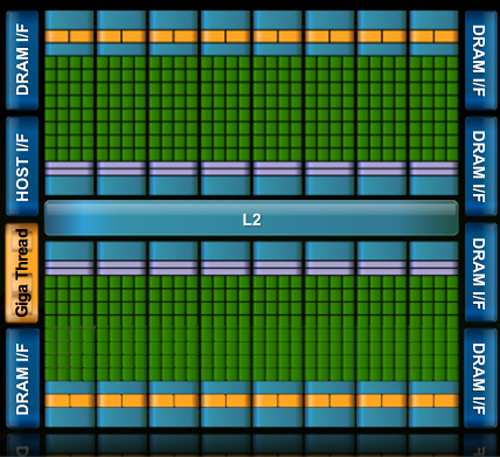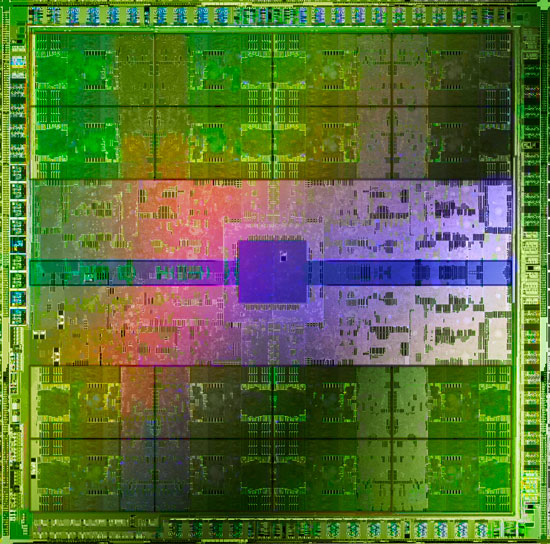At this year’s Consumer Electronics Show, NVIDIA had several things going on. In a public press conference they announced 3D Vision Surround and Tegra 2, while on the showfloor they had products o’plenty, including a GF100 setup showcasing 3D Vision Surround.
But if you’re here, then what you’re most interested in is what wasn’t talked about in public, and that was GF100. With the Fermi-based GF100 GPU finally in full production, NVIDIA was ready to talk to the press about the rest of GF100, and at the tail-end of CES we got our first look at GF100’s gaming abilities, along with a hands-on look at some unknown GF100 products in action. The message NVIDIA was trying to send: GF100 is going to be here soon, and it’s going to be fast.

Fermi/GF100 as announced in September of 2009
Before we get too far ahead of ourselves though, let’s talk about what we know and what we don’t know.
During CES, NVIDIA held deep dive sessions for the hardware press. At these deep dives, NVIDIA focused on 3 things: Discussing GF100’s architecture as is relevant for a gaming/consumer GPU, discussing their developer relations program (including the infamous Batman: Arkham Asylum anti-aliasing situation), and finally demonstrating GF100 in action on some games and some productivity applications.
Many of you have likely already seen the demos, as videos of what we saw have already been on YouTube for a few days now. What you haven’t seen and what we’ll be focusing on today, is what we’ve learned about GF100 as a gaming GPU. We now know everything about what makes GF100 tick, and we’re going to share it all with you.
With that said, while NVIDIA is showing off GF100, they aren’t showing off the final products. As such we can talk about the GPU, but we don’t know anything about the final cards. All of that will be announced at a later time – and no, we don’t know that either. In short, here’s what we still don’t know and will not be able to cover today:
- Die size
- What cards will be made from the GF100
- Clock speeds
- Power usage (we only know that it’s more than GT200)
- Pricing
- Performance
At this point the final products and pricing are going to heavily depend on what the final GF100 chips are like. The clockspeeds NVIDIA can get away with will determine power usage and performance, and by extension of that, pricing. Make no mistake though, NVIDIA is clearly aiming to be faster than AMD’s Radeon HD 5870, so form your expectations accordingly.
For performance in particular, we have seen one benchmark: Far Cry 2, running the Ranch Small demo, with NVIDIA running it on both their unnamed GF100 card and a GTX285. The GF100 card was faster (84fps vs. 50fps), but as Ranch Small is a semi-randomized benchmark (certain objects are in some runs and not others) and we’ve seen Far Cry 2 to be CPU-limited in other situations, we don’t put much faith in this specific benchmark. When it comes to performance, we’re content to wait until we can test GF100 cards ourselves.
With that out of the way, let’s get started on GF100.











115 Comments
View All Comments
dentatus - Monday, January 18, 2010 - link
Absolutely. Really, the GT200/RV700 generation of DX10 cards was inarguably 'won' (i.e most profitable) for AMD/ATI by cards like the HD4850. But the overall performance crown (i.e highest in-generation performance) was won off the back of the GTX295 for nvidia.But I agree with chizow that nvidia has ultimately been "winning" (the performance crown) each generation since the G80.
chizow - Monday, January 18, 2010 - link
Not sure how you can claim AMD "inarguably" won DX10 with 4850 using profits as a metric. How many times did AMD turn a profit since RV770 launched? Zero. They've posted 12 straight quarters of losses last time I checked. Nvidia otoh has turned a profit in many of those quarters and most recently Q3 09 despite not having the fastest GPU on the market.Also, the fundamental problem people don't seem to understand with regard to AMD and Nvidia die size and product distribution is that they overlap completely different market segments. Again, this simply serves as a referendum in the differences in their business models. You may also notice these differences are pretty similar to what AMD sees from Intel on the CPU side of things....
Nvidia GT200 die go into all high-end and mainstream parts like GTX 295, 285, 275, 260 that sell for much higher prices. AMD RV770 die went into 4870, 4850, and 4830. The latter two parts were competing with Nvidia's much cheaper and smaller G92 and G96 parts. You can clearly see that the comparison between die/wafer sizes isn't a valid one.
AMD has learned from this btw, and this time around it looks like they're using different die for their top tier parts (Cypress) and their lower tier parts (Redwood, Cedar) so that they don't have to sell their high-end die at mainstream prices.
Stas - Tuesday, January 19, 2010 - link
[quote]Not sure how you can claim AMD "inarguably" won DX10 with 4850 using profits as a metric. How many times did AMD turn a profit since RV770 launched? Zero. They've posted 12 straight quarters of losses last time I checked. Nvidia otoh has turned a profit in many of those quarters and most recently Q3 09 despite not having the fastest GPU on the market. [/quote]AMD also makes CPUs... they also lost market due to Intel's high end domination... they lost money on ATI... If it wasn't for success of the HD4000 series, AMD would've been in deep shit. Just think before you post.
Calin - Tuesday, January 19, 2010 - link
Hard to make a profit paying the rates of a 5 billion credit - but if you want to take it this way (total profits), why wouldn't we take total income?AMD/ATI:
PERIOD ENDING 26-Sep-09 27-Jun-09 28-Mar-09 27-Dec-08
Total Revenue 1,396,000 1,184,000 1,177,000 1,227,000
Cost of Revenue 811,000 743,000 666,000 1,112,000
Gross Profit 585,000 441,000 511,000 115,000
NVidia
PERIOD ENDING 25-Oct-09 26-Jul-09 26-Apr-09 25-Jan-09
Total Revenue 903,206 776,520 664,231 481,140
Cost of Revenue 511,423 619,797 474,535 339,474
Gross Profit 391,783 156,723 189,696 141,666
Not looking so good for the "winner of the generation", though. As for the die size and product distribution, all I'm looking at is the retail video card offer, and every price bracket I choose have both NVidia and AMD in it.
knutjb - Wednesday, January 20, 2010 - link
You missed my point. I wasn't talking about AMD as a whole I was talking about ATI as a division within AMD. If a company bleeds that much and still survives some part of the company must be making some money and that is the ATI division. ATI is making money. Your macro numbers mean zip.The model ATI is using is putting out competitive cards from a company, AMD, that is bleeding badly. What generation card is easier to sell the new and improved one with more features, useful or not, or the last generation chip?
beck2448 - Tuesday, January 19, 2010 - link
Those numbers are ludicrous. AMD hasn't made a profit in years. ATI's revenue is about 30% of Nvidia's.knutjb - Monday, January 18, 2010 - link
ATI is what has been floating AMD with its profits. ATI has decided to make smaller incremental developmental steps that lower end production costs.Nvidia takes a long time to create a monolithic monster that required massive amounts of capital to develop. They will not recoup this investment off gamers alone because most don't have that much cash to put one of those cards in their machines. It is needed for marketing so they can push lower level cards implying superiority, real or not, they are a heavy marketing company. This chip is directed at their GPU server market and that is where they hope to make their money hoping it can do both really well.
ATI on the other hand by making smaller steps, but at a higher cycle of product development, have focused on the performance/mainstream market. With lower development costs they can turn out new cards that payback development costs back quicker allowing them to put that capital back into new products. Look at the 4890 and 4870. They both share similar architecture but the 4890 is a more refined chip. It was a product that allowed ATI to keep Nvidia reacting to ATI's products.
Nvidia's marketing requires them to have the fastest card on the market. ATI isn't trying to keep the absolute performance crown but hold onto the price/performance crown. Every time they put out a slightly faster card it forces Nvidia to respond. Nvidia recieves lower profits from having to drop card prices. I don't think this chip will be able to function on the 8800 model because AMD/ATI is now on stronger financial footing than they have been in the past couple years and Nvidia being late to market is helping ATI line their pockets cash. The 5000 series is just marginally better, but is better than Nvidia's current offerings.
Will Nvidia release just a single high end card or several tiers of cards to compete across the board? I don't think one card will really help the bottom line over the longer term.
StormyParis - Monday, January 18, 2010 - link
I'm not sure what "winning" means, nor, really what a generation is.you can win on highest performance, highest marketshare, highest profit, best engineering...
a generation may also be adirectX iteration, a chip release cycle (in which case, each manufacturer has its own), a fiscal year...
Anyhoo, I don't really care, as long as i'm regularly getting better, cheaper cards. I'll happily switch back to nVidia
chizow - Monday, January 18, 2010 - link
I clearly defined what I considered a generation, historically the rest of the metrics measured over time (market share, mind share, profits, value-add features, game support) tend to follow suit.For someone like you that doesn't care about who's winning a generation it should be simple enough, buy whatever is best that suits your price:performance requirements when you're ready to buy.
For those who want to make an informed decision once every 12-16 months per generation to avoid those niggling uncertanties and any potential buyer's remorse, they would certainly want to consider both IHV's offerings before making that decision.
Ahmed0 - Monday, January 18, 2010 - link
How can you "win" if your product isnt intended for a meaningful number of customers. Im sure ATi could pull out the biggest, most expensive, hottest and fastest card in the world as well but theres a reason why they dont.Really, the performance crown isnt anything special. The title goes from hand to hand all the time.